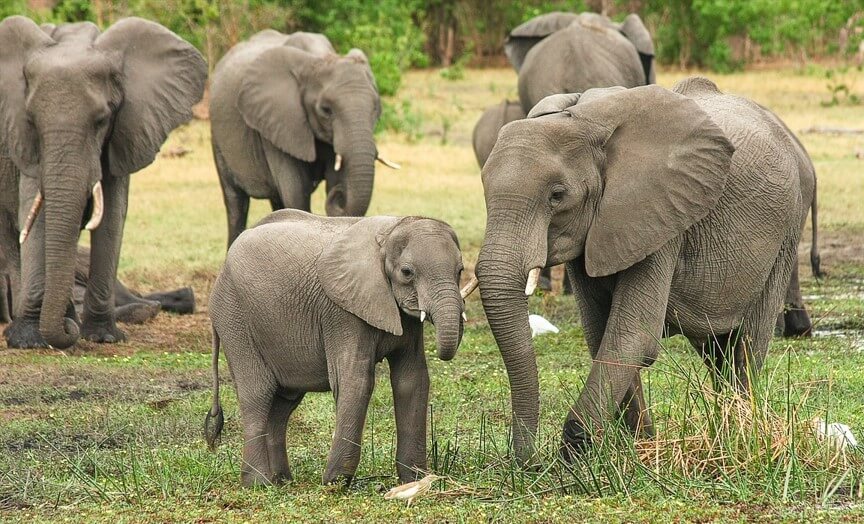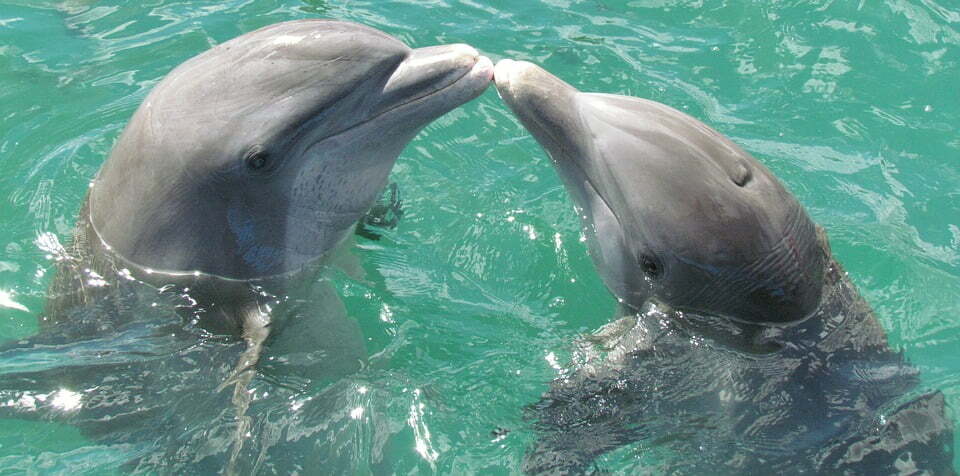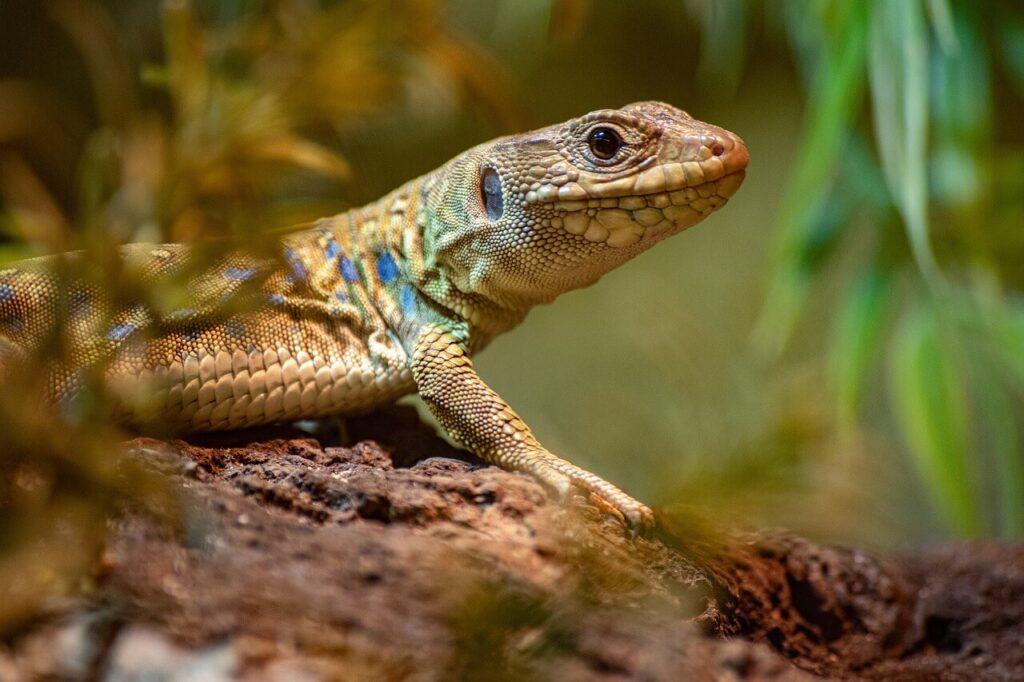
Animals do not know how to read, write or speak any language – English, Hindi, French, German, Spanish, or Sanskrit like the humans. Still it would be wrong to presume that animals are deaf or dumb and can’t communicate. On the contrary, animals have highly sophisticated and complex communication systems which helps them recognise each other, respond to distress calls and express feelings like fear, happiness, or anger. Animals use body language, as well as visual, sensory, auditory, chemical, and tactile signals to communicate with each other. Each species has its unique way to interact, and respond to each other. Communication has an essential role to play or survival, reproduction, and social bonding in the animal kingdom. It allows them to find food, reproduce, avoid predators, and cooperate with other members of their own species.
Here are some of the means of communication that different breeds of animals use:
Mammals
Elephants

Elephants are among the most intelligent mammals. They have a sophisticated and complex means of communication. Elephants use a variety of sounds, like trumpets, roars, and low-frequency rumbles known as infrasound, which can travel several miles, allowing them to communicate with other member of their herd who might be far away. While it’s not conclusively proven that elephants call each other by name like humans, research suggests they have specific vocalizations for different individuals. Each elephant has a unique rumble, which helps other members of the herd to recognize them and respond to their call. They also use body language, such as flapping of ear, trunk, and head to convey feelings and emotions. Touch is another crucial aspect of elephant communication. Individuals often caress each other with their trunks to show affection.
Dogs

Domestic dogs (Canis lupus familiaris) are known for their ability to communicate effectively with both their own species and humans using a combination of body language, and vocal signals like barking, growling, whining, or howling to express their emotions. For instance, dogs often resort to loud, repetitive, and persistent barking to alert their owners to potential intruders, while low growling is a signal of discomfort, fear, or aggression. Likewise body language is an important part of canine communication. Dogs use a wide range of body language signals to convey their emotions and intentions. A wagging tail indicates excitement or happiness. A raised, stiff tail can signal alertness or dominance, while a tail tucked between the legs indicates fear, submission, or anxiety. Scent marking through urine or faeces is another way dogs communicate, leaving information about their identity, territory, and reproductive status. Dogs can also be trained to obey their owner/ handler’s body language or voice commands
Also Read: 15 Countries where people eat dogs and cats
Cats

Domestic cats (Felis catus) are excellent communicators. They use multiple methods like vocalizations, body language, and scent marking to convey their feelings and emotions to other cats and humans. Adult cats may meow to catch their owner’s attention or convey they are hungry. They also use a variety of other vocalizations like purr (to signal contentment, anxiety or pain), hissing and growling (fear or aggression), yowl (fear or pain), and trill (greeting or invitation to play). Rubbing against you with their head or body is a sign of affection. Likewise a gentle bite or paw swipe can be a playful gesture, but a harder bite or scratch is a clear sign of annoyance. By understanding how cats communicate, we can better understand their needs and build stronger relationships with them. Cats have scent glands on their face, body, and tail which they use for scent marking to establish territory and communicate with other cats.
Birds
Parrots

Parrots, especially species like African Grey parrots, are one of the most impressive communicators known for their outstanding ability to mimic human speech and other sounds in their environment. Parrots use calls, whistles, clicks, and body language to communicate with each other and express their emotions. Their posture, crest position, feather fluffing, and eye movements can all tell you a lot about how they are feeling. Parrot are also known to use their beak to express themselves. A gentle beak touch can be a sign of affection, while grinding of the beak indicates frustration or anger. By paying attention to their vocalizations, body language, and beak movements, you can learn to understand what your parrot is trying to tell you. Just like domestic parrots, wild parrots too use body language to express their emotions. Some species of parrots, like the Macaws may spread their brightly coloured feathers to attract mates and defend their territory as well as indicate their health and social status. In the wild, parrots use their vocalizations to stay in touch with each other, especially when foraging or flying long distances. They use loud calls to signal danger or to find other members of their flock.
Songbirds

Songbirds, such as the nightingale and canary, use songs to attract mates, defend their territory, and signal alarm. Each songbird species has a distinctive song pattern. One of the primary functions of birdsong is to attract mates. Male songbirds sing to demonstrate their fitness and genetic quality to potential female mates. The complexity, volume, and duration of the song indicates the male’s overall health and vitality. Males with larger repertoires are often more successful in attracting mates. The quality of the song, including its clarity and accuracy, can also be a deciding factor for females when selecting a mate. Birdsong also plays a crucial role in territorial defence to warn other males to stay away. Some songbirds use simpler calls to communicate with each other, signal danger, food source, or their location to other flock members.
Marine Animals
Dolphins

Dolphins are one of the most intelligent animals in the marine world. They are masters of underwater communication with a sophisticated and complex communication system that includes vocalizations, body language, tactile interactions, and echolocation. Dolphin communication is a complex and fascinating area of study. Scientists are still learning more about the nuances of their underwater communication system. Dolphins use a combination of clicks, whistles, and body language to communicate with each other. Each dolphin has a unique high-pitched signature whistle which is like their name and allows other dolphins to identify and call them. The signature whistle also communicates their emotional state. Dolphins are also known to use echolocation, a kind of biological sonar to navigate and hunt in the aquatic environment. Dolphins also use body language, facial expressions or eye movements to express their emotions. Dolphins often rub against each other particularly among family members and close associates to strengthen social ties. Communication between mother dolphins and their calves is crucial for the calf’s survival. Mothers use a variety of vocalizations, including signature whistles, to keep track of and instruct their young.
Whales

Whales possess some of the most sophisticated communication systems in the animal kingdom, which includes a combination of vocalizations, body language, and environmental interactions. Whales, particularly humpback whales (Megaptera novaeangliae), are famous for their complex songs, which can last for hours and travel long distances underwater. These songs are believed to play a role in mating and social bonding. Each population of humpback whales has its unique song, and individuals can recognize and respond to these vocalizations. Other whale species, such as orcas, use a variety of clicks, whistles, and pulsed calls to communicate within their pods. These vocalizations help maintain group cohesion, coordinate hunting, and convey social information. Understanding whale communication is an ongoing scientific endeavour. However, one thing is clear: whales possess a remarkable ability to communicate across vast distances and complex situations using a sophisticated blend of vocalizations and body language.
Insects
Bees

Honeybees (Apis mellifera) have a highly developed communication system. One of the most well-known forms of communication among bees is the waggle dance, which honeybees use to communicate the location of food sources to other members of the colony. In the waggle dance, a returning forager bee moves in a figure-eight pattern, waggling its abdomen to indicate the direction and distance to the food source relative to the position of the sun. Bees also communicate through pheromones, which are chemical signals that convey information about things like the location of the hive, the presence of danger, or the need to find a new nesting site. By using these forms of communication, bees are able to work together as a cohesive unit to ensure the survival and success of the colony.
Ants

Ants are tiny insects, but their communication methods are complex and effective. Ants (Formicidae) rely heavily on chemical communication through pheromones. Ants use pheromones to leave a trail for other ants to follow. When an ant finds food, it will lay down a pheromone trail as it returns to the colony. The trail works like a highway for other ants to reach the food source. The strength of the pheromone trail can even indicate the quality and quantity of the food source, allowing the colony to efficiently allocate its workers. Ants also use their antennae to touch and tap other ants, to convey information about things like the location of food or potential threats. Some ant species are also known to produce sounds by rubbing together of body parts, to communicate with other ants. On the whole ants are highly social insects who rely on communication to coordinate and ensure the success of the entire colony.
Reptiles
Lizards

Lizards are fascinating creatures which use multiple communication channels like visual signals, chemical signals, and sometimes vocalizations to communicate with each other. Male lizards often display bright colours and perform elaborate push-ups to attract females and establish territory. Some lizards, like chameleons, can change their colour to indicate their mood, such as aggression or submission, and also to attract mates. These visual signals convey information about the lizard’s health, strength, and reproductive status. Some lizard species also use chemical signals, such as pheromones, to communicate with each other. Lizards also use tail movements, like curling or twitching, to communicate with potential predators or other lizards. Communication helps lizards maintain social order within groups, identify kin, and coordinate activities.
Snakes

Snakes primarily rely on their body language, and chemical signals to communicate. They use their tongues to pick up scent molecules from the environment and the Jacobson’s organ to analyse these chemical cues. Pheromones play a crucial role in snake communication, especially during mating season. Male snakes follow pheromone trails left by females to locate potential mates. Pheromones left by other snakes on the ground, rocks, or vegetation can communicate information like presence of another snake, mating receptivity, and danger or threats. During courtship, male snakes may engage in tactile communication by rubbing against the female’s body to stimulate her and encourage mating. Some snake species also use visual signals to communicate aggression or submission. A snake may coil its body, hiss, or flatten its head and neck to appear larger and more threatening to potential predators or rivals. Some breeds of snakes like rattlesnakes engage in a ritualized combat dance and intertwine their bodies to establish dominance and win the right to mate with a female. The rattling of their tails acts as a warning signal for potential predators.
Amphibians
Frogs

Frogs are masters of vocal communication. Frogs use a rich and varied soundscape to communicate with each other, particularly during the breeding season. Male frogs produce calls to attract females and to establish territory. Each species has a distinct call, which helps females identify and locate males of their own species. Male frogs also use calls to defend their territory from other males. These calls can vary in intensity and frequency, signalling the presence and fitness of the calling male. A key feature in frog communication is the vocal sac, a balloon-like pouch located near the throat. When this sac is filled with air, it amplifies the sounds and makes it travel over long distance. These vocal sacs are more prominent in male frogs. Some frogs emit distress calls which can startle the predator and give the frog a chance to escape. Frog calls are commonly heard at night, because nocturnal activity and the damp environment at night makes sound travel long distances. Frogs also use visual signals, such as colour changes and body movements, to communicate with each other.
Salamanders

Salamanders lack vocal cords and rely primarily on chemical communication, visual displays, and tactile interactions. However, that doesn’t mean that Salamanders are silent! Chemical communication is crucial for salamanders, especially during mating. Males produce pheromones to attract females and to indicate their presence and readiness to mate. Touch is another important way salamanders communicate. Some salamander species also use tactile communication, such as rubbing and nudging, during courtship. Salamanders use their environment to enhance communication, such as positioning themselves in areas where their visual or chemical signals can be most effectively received by others.
Fish
Cichlids

Cichlids are a large and diverse family of freshwater fish known for their vibrant colours, interesting behaviours, and complex communication methods. Cichlid fish, particularly those in African Rift Lakes, have developed a complex communication system involving visual, auditory, and chemical signals. Their body language, colour changes, and fin play a significant role in conveying information. Males often display vibrant colours and perform intricate courtship dances to attract females. These visual signals convey information about the male’s health and fitness. Cichlids also use chemical signals to communicate, releasing pheromones to indicate reproductive status and establish territory. Touch also plays a role in cichlid communication. During courtship, breeding pairs may nudge or rub against each other. In some species, the male cichlid will touch the female’s mouth with his fins to encourage her to lay eggs.
Clownfish

Clownfish are vocal creatures that communicate with each other using sounds! Clownfish produce sounds such as pops, clicks, and chirps, which play an important role in their social hierarchy and help maintain order within the group. Interestingly, the sound made by clownfish is related to its size. Larger fish produce lower frequency sounds with longer pulses, while smaller fish use higher frequency sounds with shorter pulses. This might help small clownfish quickly assess the size and dominance of the bigger fish without picking a fight. Clownfish, also use a combination of visual and chemical signals to communicate. Clownfish use body language, such as fin displays and movements, to convey social status. Chemical signals also play a role in coordinating reproductive behaviour and ensuring group stability.
Birds of Prey
Eagles

Eagles use a combination of vocalizations and body language to communicate. Eagles produce a range of calls, such as whistles, chirps, and screeches, to defend their territory from intruders, attract mates or communicate with a partner, and to warn others of potential dangers or predators. Eagles use body postures and movements to communicate with each other. For example ruffled feathers, spread wings, and a lowered head can signal aggression or dominance. On the other hand, aerial displays, such as cartwheels and dives, play a part in courtship rituals. Eagles also use tactile communication, particularly during courtship, when pairs engage in mutual preening and gentle pecking to strengthen their bond.
Owls

Owls rely on a complex system of hoots, screeches, whistles, and clicks to communicate with each other, especially during the breeding season. Each owl species has a distinctive call. One of the most common reasons owls call is to defend their territory. Male owls often hoot to let potential mates know they are available. The hoots can also signal the quality of the male’s territory, which can be important to females looking for a place to raise their young. A well-placed hoot can warn other owls to stay away. These vocalizations serve to establish territory, attract mates, and communicate with offspring. Owls use body postures and movements to judge distance and assess their environment as well as to communicate their feelings and emotions. For instance puffed up feathers can make an owl appear larger and more intimidating to potential threats. Spreading wings can be a defensive gesture or part of a courtship. The size of an owl’s eyes and the intensity of their gaze can communicate mood or intention.
Primates
Chimpanzees

Chimpanzees are highly intelligent primates with a complex communication system. Known for their noisiness, Chimpanzees use around a dozen distinct sounds, including hoots, barks, pants, screams, and laughter to communicate. Chimpanzees are masters of body language. They use facial expressions, gestures, postures, and even touch to communicate with each other. A relaxed posture with open arms might signal friendliness, while a tense posture with bared teeth might indicate aggression. Chimpanzees are also adept at using facial expressions, such as grimaces, grins, and lip smacks, to convey their emotions. Like humans, chimps too use gestures to communicate and may use a hand to wave or share an object.
Gorillas

Gorillas have a rich communication system comprising vocalizations, body language, and even touch to convey their thoughts and feelings to each other. They have around 22 distinct vocalizations including grunts, roars, and barks, to convey information about their territory, social status, and emotional state. Body language, such as chest beating, ground slapping, and posturing, is used to assert dominance, attract mates, and deter rivals. Gorillas also engage in grooming and gentle touch to strengthen social bonds and reassure group members. Overall, gorillas have a complex system of communication that allows them to convey a wide range of messages and maintain social bonds within their groups.
Conclusion

The communication methods employed by different animal breeds are as diverse as the species themselves. From the sophisticated vocalizations of elephants and dolphins to the intricate dances of bees and birds, animals have evolved a myriad of ways to convey information essential for survival and social interaction. Understanding these communication systems not only enhances our appreciation of the animal kingdom but also provides insights into the evolution of social behaviour and the complexities of interspecies interactions. As we continue to study and learn from these remarkable creatures, we gain a deeper understanding of the rich tapestry of life on Earth.

